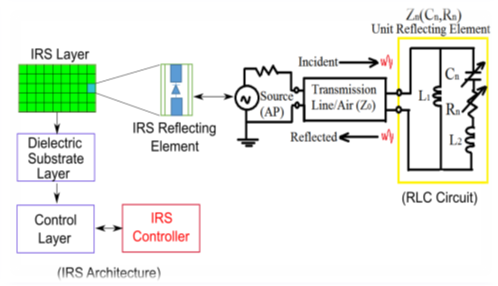A Survey - Intelligent Reflecting Surface Beyond 5G
DOI:
https://doi.org/10.58564/IJSER.2.2.2023.69Keywords:
Intelligent reflecting surface (IRS) , wireless communications , metasurface , reconfigurable intelligent surface (RIS)Abstract
In the coming decade, we'll see the rollout of the intelligent information society—a highly digitalized, intelligent civilization that draws inspiration from AI and runs on global data. Next-generation or modern communication networks are crucial to bringing this ambitious plan to fruition because of their promise of universal connectivity, full 360-degree wireless coverage, and the seamless integration of all necessary functions to power truly vertical apps. Research in this area has shown that the Intelligent Reflective Surface (IRS) combined with wireless environment management capability is a viable solution for 6G technology. To be more specific, the IRS is capable of precise 3D passive beam formation due to the wavefront's phases, amplitude, frequency, and polarization being controlled intelligently by tunable components. In this article, we provide an overview of the IRS, including categorizing recent IRS research theory, and we also review IRS's structure, controller, tunable chips, and design hardware architecture. Finally, as a timely review of the IRS, our summary will be of interest to both researchers and practitioners involved.
References
Zhang, H., Di, B., Song, L., & Han, Z. (n.d.). Reconfigurable Intelligent Surfaces assisted Communications with Limited Phase Shifts: How Many Phase Shifts Are Enough?
Hassouna, S., Rains, J., urRehmanKazim, J., Ur Rehman, M., Ali Jamshed Mohammad Abualhayja, M., Mohjazi, L., Jun Cui, T., Ali Imran, M., &Abbasi James Watt, Q. H. (2022). A Survey on Intelligent Reflecting Surfaces: Wireless Communication Perspective. DOI: https://doi.org/10.1049/cmu2.12571
Li, X., Fang, J., Gao, F., & Li, H. (2019). Joint Active and Passive Beamforming for Intelligent Reflecting Surface-Assisted Massive MIMO Systems.
Okogbaa, F. C., Ahmed, Q. Z., Khan, F. A., Abbas, W. bin, Che, F., Zaidi, S. A. R., &Alade, T. (2022). Design and Application of Intelligent Reflecting Surface (IRS) for Beyond 5G Wireless Networks: A Review. In Sensors (Vol. 22, Issue 7).MDPI DOI: https://doi.org/10.3390/s22072436
Zhao, J. (2019). A Survey of Intelligent Reflecting Surfaces (IRSs): Towards 6G Wireless Communication Networks.
Sharma, T., Chehri, A., & Fortier, P. (2021). Reconfigurable Intelligent Surfaces for 5G and beyond Wireless Communications: A Comprehensive Survey. Energies, 14(24), 8219 DOI: https://doi.org/10.3390/en14248219
Mirza, J., & Ali, B. (2019).Channel Estimation Method and Phase Shift Design for Reconfigurable Intelligent Surface Assisted MIMO Networks.
Gong, S., Lu, X., Hoang, D. T., Niyato, D., Shu, L., Kim, D. I., & Liang, Y.-C. (2019). Towards Smart Wireless Communications via Intelligent Reflecting Surfaces: A Contemporary Survey. DOI: https://doi.org/10.1109/COMST.2020.3004197
Pérez-Adán, D., Fresnedo, Ó., Gonzalez-Coma, J. P., &Castedo, L. (2021). Intelligent reflective surfaces for wireless networks: An overview of applications, approached DOI: https://doi.org/10.3390/electronics10192345
Patel, A., &Shukla, A. (2022).A review on intelligent reflecting surface-based terahertz communication.In Indonesian Journal of Electrical Engineering and Computer Science (Vol. 25, Issue 3, pp. 1580–1588).Institute of Advanced Engineering and Science. DOI: https://doi.org/10.11591/ijeecs.v25.i3.pp1580-1588
Zhou, T., Xu, K., Xie, W., Shen, Z., Wei, C., Liu, J., & Sun, L. (2021). Aerial intelligent reflecting surface-enhanced cell-free massive MIMO for high-mobility communication: joint Doppler compensation and power optimization. Eurasip Journal on Advances in Signal Processing, 2021(1). DOI: https://doi.org/10.1186/s13634-021-00781-z
Mei, W., Zheng, B., You, C., & Zhang, R. (2021).Intelligent Reflecting Surface Aided Wireless Networks: From Single-Reflection to Multi-Reflection Design and Optimization. DOI: https://doi.org/10.1109/JPROC.2022.3170656
Björnson, E., Wymeersch, H., Matthiesen, B., Popovski, P., Sanguinetti, L., & de Carvalho, E. (2021). Reconfigurable Intelligent Surfaces: A Signal Processing Perspective With Wireless Applications. DOI: https://doi.org/10.1109/MSP.2021.3130549
Basar, E., &Yildirim, I. (2020). Reconfigurable Intelligent Surfaces for Future Wireless Networks: A Channel Modeling Per DOI: https://doi.org/10.1109/MWC.001.2000338
Wymeersch, H., He, J., Denis, B., Clemente, A., &Juntti, M. (2020). Radio Localization and Mapping with Reconfigurable Intelligent Surfaces: Challenges, Opportunities, and Research Directions. IEEE Vehicular Technology Magazine, 15(4), 52–61spective. DOI: https://doi.org/10.1109/MVT.2020.3023682
Costa, F., &Borgese, M. (2021).Electromagnetic Model of Reflective Intelligent Surfaces.IEEE Open Journal of the Communications Society, 2, 1577–1589. DOI: https://doi.org/10.1109/OJCOMS.2021.3092217
Sievenpiper, D. F., Schaffner, J. H., Jae Song, H., Loo, R. Y., & Tangonan, G. (2003). Two-Dimensional Beam Steering Using an Electrically Tunable Impedance Surface. IEEE Transactions on Antennas and Propagation, 51(10 I), 2713–2722. DOI: https://doi.org/10.1109/TAP.2003.817558
Zhang, H., Zhang, X., Ma, X., Pu, M., Huang, C., Zhang, Z., Wang, Y., Guo, Y., Luo, J., &Luo, X. (2022). Full-space beam scanning based on transmission reflection switchable quadratic phase metasurface. Optics Express, 30(20), 36949. DOI: https://doi.org/10.1364/OE.472546
di Renzo, M., Zappone, A., Debbah, M., Alouini, M.-S., Yuen, C., de Rosny, J., &Tretyakov, S. (2020).Smart Radio Environments Empowered by Reconfigurable Intelligent Surfaces: How it Works, State of Research, and Road Ahead. DOI: https://doi.org/10.1109/JSAC.2020.3007211
Alnajjar, H., & Hameed, A. M. (n.d.). Effect of Bidirectional Reflector Technology on the Non-line-of-sight propagation of Light Fidelity System 1 st Satea
Wang, C., Xu, H. X., Wang, Y., Hu, G., Luo, H., & Wang, K. (2023). Reconfigurable transmissivemetasurface synergizing dynamic and geometric phase for versatile polarization and wavefront manipulations.Materials and Design, 225. DOI: https://doi.org/10.1016/j.matdes.2022.111445
Jian, M., Alexandropoulos, G. C., Basar, E., Huang, C., Liu, R., Liu, Y., & Yuen, C. (2022). Reconfigurable intelligent surfaces for wireless communications: Overview of hardware designs, channel models, and estimation techniques. Intelligent and Converged Networks, 3(1), 1–32. DOI: https://doi.org/10.23919/ICN.2022.0005
Yigit, Z., Basar, E., & Altunbas, I. (2022). Over-the-air beamforming with reconfigurable intelligent surfaces. Frontiers in Communications and Networks, 3. DOI: https://doi.org/10.3389/frcmn.2022.1016270
Faisal, K. M., & Choi, W. (2022). Machine Learning Approaches for Reconfigurable Intelligent Surfaces: A Survey. IEEE Access, 10, 27343–27367. DOI: https://doi.org/10.1109/ACCESS.2022.3157651
Yuan, X., Zhang, Y.-J. A., Shi, Y., Yan, W., & Liu, H. (2020). Reconfigurable-Intelligent-Surface Empowered Wireless Communications: Challenges and Opportunities. DOI: https://doi.org/10.1109/MWC.001.2000256
Liu, Y., Liu, X., Mu, X., Hou, T., Xu, J., di Renzo, M., & Al-Dhahir, N. (2020).Reconfigurable Intelligent Surfaces: Principles and Opportunities. DOI: https://doi.org/10.1109/COMST.2021.3077737
Sur, S. N., &Bera, R. (2021). Intelligent reflecting surface assisted MIMO communication system: A review. In Physical Communication (Vol. 47). Elsevier B.V. DOI: https://doi.org/10.1016/j.phycom.2021.101386
Zhang, Y., Di, B., Zhang, H., Lin, J., Li, Y., & Song, L. (2020).Beyond Cell-free MIMO: Energy Efficient Reconfigurable Intelligent Surface Aided Cell-free MIMO Communications. DOI: https://doi.org/10.1109/TCCN.2021.3058683
Dakulagi, V., & Bakhar, M. (2020). Advances in Smart Antenna Systems for Wireless Communication. In Wireless Personal Communications (Vol. 110, Issue 2, pp. 931–957). Springer. https://doi.org/10.1007/s11277-019-06764-6 DOI: https://doi.org/10.1007/s11277-019-06764-6
Ding, Z., Zhong, C., Ng, D. W. K., Peng, M., Suraweera, H. A., Schober, R., & Poor, H. V. (2014). Application of Smart Antenna Technologies in Simultaneous Wireless Information and Power Transfer DOI: https://doi.org/10.1109/MCOM.2015.7081080
Dai, L., Renzo, M. di, Chae, C. B., Hanzo, L., Wang, B., Wang, M., Yang, X., Tan, J., Bi, S., Xu, S., Yang, F., & Chen, Z. (2020). Reconfigurable Intelligent Surface-Based Wireless Communications: Antenna Design, Prototyping, and Experimental Results. IEEE Access, 8, 45913–45923. https://doi.org/10.1109/ACCESS.2020.2977772 DOI: https://doi.org/10.1109/ACCESS.2020.2977772
Imran, M. A., Chattha, H. T., Kiourti, A., He, Y., Hashmi, R. M., Alam, M. Z., Alomainy, A., & Abbasi, Q. H. (2020). IEEE Access Special Section: Antenna and Propagation for 5G and beyond. In IEEE Access (Vol. 8, pp. 207343–207351). DOI: https://doi.org/10.1109/ACCESS.2020.3037625

Downloads
Published
How to Cite
Issue
Section
License
Copyright (c) 2023 Areej Abdulkareem, Satea H. Alnajjar

This work is licensed under a Creative Commons Attribution-NonCommercial-NoDerivatives 4.0 International License.
Deprecated: json_decode(): Passing null to parameter #1 ($json) of type string is deprecated in /var/www/vhosts/ijser.aliraqia.edu.iq/httpdocs/plugins/generic/citations/CitationsPlugin.inc.php on line 49









